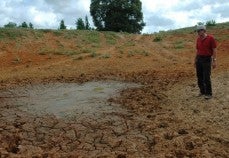Severe Weather & Agriculture; Local Food Systems & Job Creation
The following publications address two different issues, but I believe many of you will relate strongly to one or both. The first is an article on La Nina and the effect of extreme drought in the South and severe weather elsewhere elsewhere on agriculture (a link to related articles follows). The second is a new report on the potential benefit that public investment in local and and regional food systems could have on job creation. -TR
La Nina Return May Prolong Drought (by Bryce Anderson, DTN Progressive Farmer)
EXCERPT: In the past year, U.S. crop areas have been buffeted by the effects of the strongest La Nina in almost 100 years. La Nina describes Pacific Ocean equatorial waters having cooler-than-average temperatures. In the U.S., the weather effects of La Nina include drier conditions in the Southern Plains and Midwest, and above-average precipitation during winter in the northern states.
For news on the devastating drought in Texas and severe weathter throughout the US, you can view a number of articles and videos at: https://article.wn.com/view/2011/05/10/Texas_Drought_2011_State_Endures_Driest_7Month_Span_On_Recor/
Market Forces: Creating Jobs Through Public Investment in Local and Regional Food Systems. (A Report by Jeffrey K. O’Hara, Union of Concerned Scientists, August, 2011, 35 Pages.)
Conservative estimates by the U.S. Department of Agriculture (USDA) suggest that more than 136,000 farms are currently selling food products directly to consumers.
EXCERPT: Markets for locally and regionally produced food are now ubiquitous across the United States. Most of them emerged over the last several decades through the tireless efforts of entrepreneurs, community organizers, farmers, and food and farm policy advocates. In particular, farmers markets and community-supported agriculture systems (CSAs)—in which consumers buy shares of local farm harvests in advance and then routinely reap the bene”ts in the form of fresh food—have expanded rapidly and are now established as family-shopping venues in many cities and towns. Schools, restaurants, supermarkets, and other mainstream institutions are also buying food from local farmers. As a result, innovative farmers are able to develop and expand businesses that generate income in rural communities. Most of these markets were independently conceived as grassroots initiatives, and as such each of them contributes uniquely to its community. These achievements have been particularly remarkable in that they have been mostly self-sufficient—realized without the government subsidies that the increasingly consolidated mainstream food system receives. This report shows that local and regional food systems could expand further, with the potential for creating tens of thousands of jobs in rural communities—many of which are struggling economically—and in urban communities as well. For example, the U.S. Department of Agriculture (USDA), in its “MyPlate” dietary guidelines, recommends that Americans eat significantly more fruits and vegetables; in many regions, local farmers could grow a substantial portion of this additional produce in peak growing season. Regional food systems could also increase market access for regional meat and dairy producers, thereby helping to foster competition in markets that have experienced signignificant consolidation in recent decades. Overall, the expansion of local and regional food systems could complement the nation’s existing mechanisms for food production, distribution, and consumption. Greater investment in local and regional food systems would thus be an essential step for agriculture policies that seek to support such economic activity.




 Your Privacy Choices
Your Privacy Choices
Leave a comment